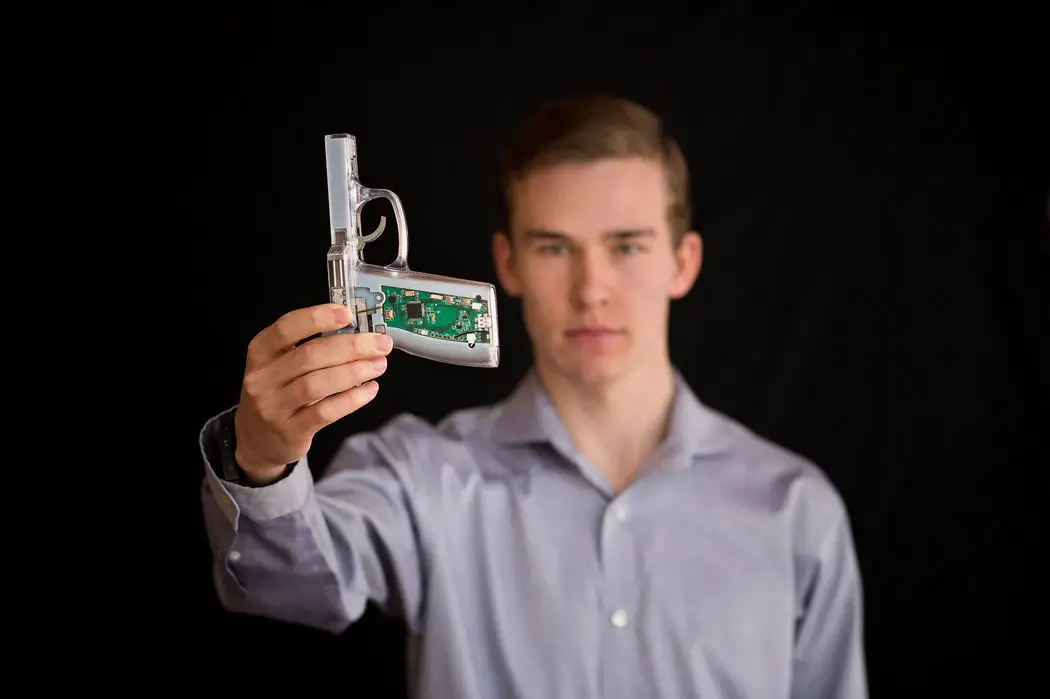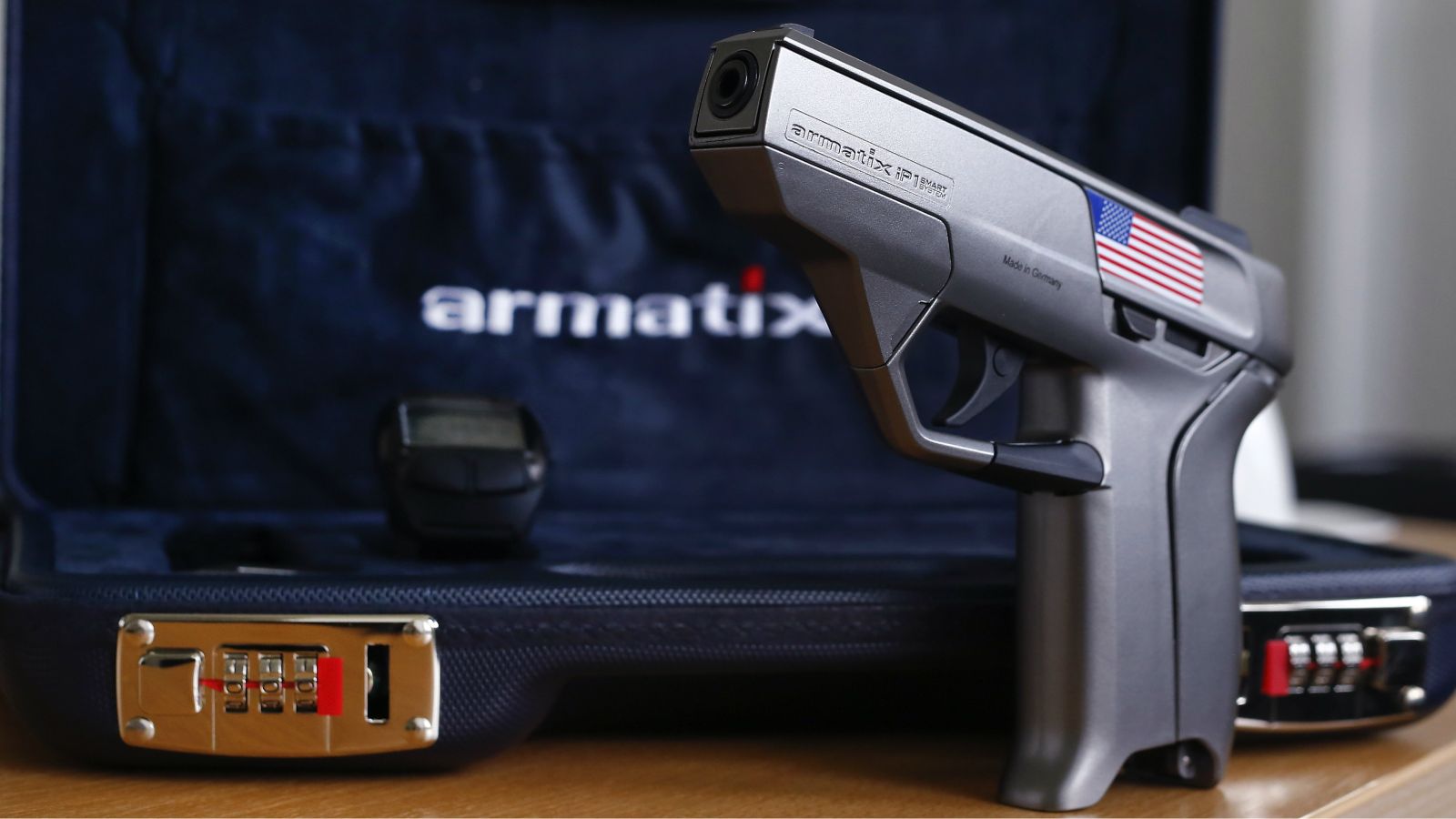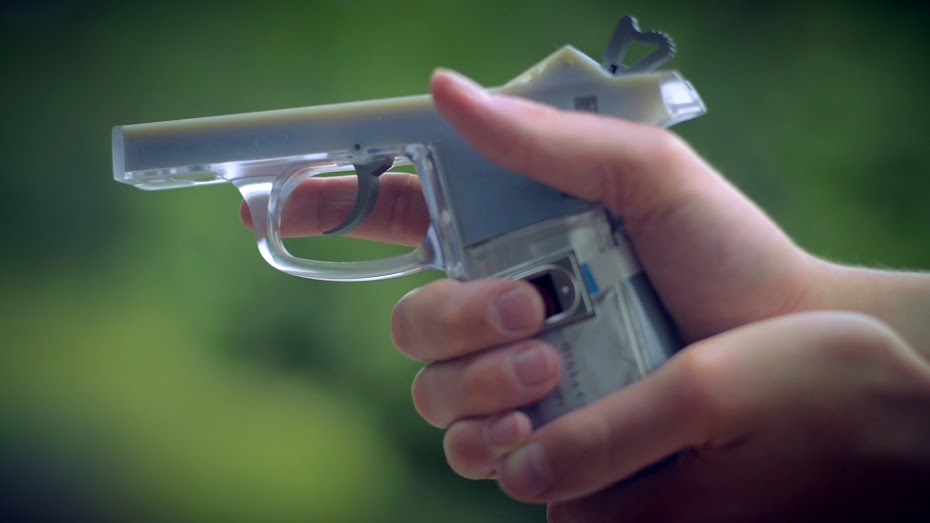No one can deny the critical role technology plays in the everyday lives of people, as it is practically everywhere: at your job, on your campus and certainly in your house. Most devices these days are guarded by passwords which, when entered incorrectly, ask personal questions concerning the individual who owns the device. The security feature makes hacking all the more difficult, though, even if there is a security breach, there are dozens resources users can turn to in order to restore that safety. Safety, therefore, has become the primary characteristic the technological era has afforded users.
The advancement of security, and the ease-of-mind that it has provided smart phone users, is a prime example of safety technology, an umbrella term used for devices that protect their users. Yet, as recently as 2002, safety technology has taken on a completely different definition.
The term began its association with the right to bear arms around 2003, though it also included non-lethal self-defense devices such as tasers and hidden surveillance cameras. The phrase “smart technology” later became associated almost exclusively with smart guns, a type of firearm that has been programmed to shoot only when handled by the authorized owner.

Although there are plenty of other types of smart guns that date back to the 1970s, both the means of production and the producer himself have helped make Kai Kloepfer’s weapon revolutionary.
Though Kloepfer is now a nineteen-year-old freshman at MIT, he originally began working on the safety gun for a science fair while he was a freshman in high school.
Kloepfer’s still-evolving smart gun prototype functions much like regular guns do, with one huge difference—there will be a fingerprint-recognition scanner on the handle. As a result, only the owner would be able to shoot and pull the trigger, meaning that even if the gun falls into the wrong hands, it would be impossible to use.
“This means that unauthorized people—such as children finding a firearm in their house, or teenagers looking to commit suicide—are unable to access firearms that are owned by other people such as their parents,” Kloepfer told CBS News in an interview.
The prototype even charges like a smart phone, with a cable and an outlet, making the gun’s care fairly easy.
Kloepfer believes that the responses he’s received in regards to the smart gun have been favorable. Indeed, Nicholas Kristof, a writer for “The New York Times” contributed a positive review of the idea in 2015.
“A child can’t fire the gun. Neither can a thief—important here in a country in which more than 150,000 guns are stolen annually,” Kristof wrote in the “Sunday Review.”
When asked about his dedication to the creation of the smart gun prototype, Kloepfer cites the shooting that took place in a movie theater at Aurora, Colorado, in July 2012. Kloepfer was only fifteen-years-old at the time, and the fact that he lived only forty-five minutes away left him thinking that he could have easily been a target. He claims that it’s this feeling of insecurity that prompts people into action.
Coni Sanders, a forensic therapist, agrees full-heartedly that losing, or nearly losing, someone to firearms violence motivates people to involve themselves with gun safety. She claims that those who do not support the smart gun going into the market simply have not felt that fear or loss. Sanders knows the feeling well herself, as her father was gunned down while teaching at Columbine High School.
“My father was a teacher for twenty-five years. He was a coach. He was a dad and he was a husband. It was unbelievable, that kind of pain. People can’t understand. If they did understand, they’d be doing things differently,” Sanders said to UPROXX.
However, there are those who question whether the good intentions of such a young and inexperienced student will actually help.
Jared Campbell, a former marine and operations manager at the Family Shooting Center in Colorado, doesn’t see Kloepfer’s smart gun as the most useful tool.
“It’s not useful. Everyone in the army uses gloves. It’s mandatory to. Another experience from overseas, I didn’t always shoot with a nice, high proper grip. There are just so many unknown variables when it comes to combat,” Campbell shared with UPROXX. “With technology, there’s always an issue of reliability. With guns, failure is not an option.”
This could be the reason why Kloepfer has taken more than four years to attach a fingerprint recognition scanner on a gun.
“Why did it take four-and-a-half years to put a fingerprint reader on the side of a gun?” CBS News correspont Tony Dokoupil asked Kloepfer.
“Well, it’s not as simple of a process as you might imagine,” he replied. “It’s also not something anybody has ever done before.”
There can be nothing truer than that. Since the 1970s, no one has created the gun Kloepfer has developed, though many have tried; while prototypes have been made, all have failed in test runs. The one smart gun that did work, the Armatix iP1, which requires being in close proximity to the electronic chip installed in the accompanying wristwatch, was forced to disappear from the market.

Out of a fear of having their Second Amendment rights violated, pro-gun activists went as far as to threaten a gun dealer in Maryland who had the nation’s first Armatix iP1 guns on shelves. The event has left gun-control advocates unsure about taking the smart gun into legislature, and has instilled doubts about how the country will react to the incorporation of smart guns into the market.
In particular, the National Rifle Association (NRA) is cautious about what implications the supposedly-safe gun could present. Of all the states in America, only New Jersey has unequivocally shown support for bringing the safe gun to market. Their Childproof Handgun Act stipulates that after smart guns have entered the market and remained on shelves for a minimum of three years, they will then become mandatory.
The campaign was deemed a battle for the NRA, one that has been resolved through compromise. The New Jersey senate majority leader, Loretta Weinberg, promises to repeal the law if the NRA halts all future interferences in the selling of smart guns.
“If, in fact, they [the NRA] would get out of the way of preventing the research, development, manufacture, distribution and sale [of smart guns], I would move to repeal this law in the state of New Jersey,” Weinberg said in an interview with MSNBC’s Chris Hayes.
Today, firearms proponents and critics are still embroiled in debate about Kloepfer’s smart gun, which he has deemed “relatively reliable.”
Can the weapon’s increased safety convince gun owners to adopt a weapon that is inconsistent, requires a small delay to recognize the fingerprint before shooting and disregards combat variables? What if doing so eliminated the 700-800 deaths that occur annually from accidental shootings? What’s more important?
*Update: The article has been amended to reflect that 700-800 deaths occur annually from accidental shootings.*











A) the Armatix was not “forced from the market”. It failed because .22lr is not an effective self defense caliber, and no one wants to pay 2400$ for a .22 pistol when you can have a better, more reliable one for around 200$
B) if this person’s product ever comes to market, the inevitable lawsuits from people killed because of a malfunction in the technology will bankrupt the company and sink the future of his gun.
C) there were 489 unintentional firearm deaths in 2015. Where is the author getting his 60,000 deaths figure?
There weren’t even close to 60,000 firearm deaths from all causes combined in 2015.
Passwords are fine for Facebook but it’s stupid to stake your life on them. Besides, these modern phones are notoriously unreliable, routinely hacked and nobody gets hurt.
So what’s preventing the Fascist Government locking up your guns so you cant use it against them. Dumb idea, it will never make it.
UM… citation needed. where the fuck does this author get this 60,000 ANNUAL accidental deaths from guns. i can just tell of the top of my head that is false. but, then i looked it up and the accidental deaths for the last five years are all way less than 1000 accidental gun deaths per year. this author is lying to make their case and that invalidates their argument. more fake news from liberal useful idiots. this article even links to another article about this kid and his stupid gun. in that article they state that there are around 600 accidental firearms deaths annually.
iphones can still make emergency calls when they are locked. if we are going with this technological analogy, will the gun still be able to used in an emergency situation when locked?
Fingerprint biometrics are not guaranteed enough for firearms. Have you ever tried using one if you had any sort of film on your finger like soda? It won’t work. What I would want is a mechanical PIN mechanism say via a 8 position joystick or 4 buttons that I can operate with my thumb, enter the right sequence that only takes 2 seconds, and the gun will unlock for 8 bullets – a magazine. Mechanical only because battery would not be an issue otherwise a low power solution that guarantees it will work if you don’t use/charge the gun for up to a year.
A home defense gun has to be 100% reliable, my iPhone is anything but. I use a fingerprint scanner to pull meds at the hospital I work for, and it has 50% success rate (and god help you if your hands are wet). Battery life is measured in years for firearm accessories, is the battery life comparable in these smart guns? I’m all for firearm safety but the technology is sadly no where near ready.
Politics first. The NRA, and other reputable self-defense rights organizations, are not opposed to smart gun technology. The opposition is to it being legislated. If in fact it becomes a government mandate, it will become problematic – already the government has demonstrated a childlike eagerness to hack into our digital devices. If our guns are digital, I can guarantee hacking will be undertaken.
Smart guns should never be legislated. If I want to buy another GLOCK 19 rather than a gee-whiz New York City Politically-Correct Peashooter iP22LR001.1 then I should be. Heck, I’ll 3D print a “dumb” gun if I feel like it.
Scenario:
LE are in the area serving a high-risk warrant. They turn on their “kill switch” which locks down all smart weapons within a 1km radius. Even if you don’t think you gun has the logic in it, it probably would. Lots of devices that aren’t obviously wireless are suddenly shown to have wireless capabilities when inspected. While LE is serving their warrant, your gun is offline. And you are vulnerable.
Scenario:
It’s not hideously difficult to track digital devices. Suddenly the government gets that firearms registry they’ve always wanted. In the words of the student’s favorite grey lady, Dianne Feinstein – “Mr & Mrs America, turn ’em all in!”
Scenario:
Nothing is 100% secure, even the magical government kill switch. Someone who misbehaves even more than the government builds one, or steals one. Crime sprees ensue since they can shut down firearms in their victims’ homes.
OK, enough politics. I’m guessing most of your readership will hate what I just said anyways.
Practical considerations.
I have yet to meet a biometric (or otherwise) unlocking device which responds in less than a second. When you are deploying your firearm in an emergency, every second counts. I can have my traditional VP9 out of my holster and on target in under two seconds, with a reasonably-placed shot maybe a quarter of a second later. And I suck.
A smart gun? Threat – draw – beep beep beep authenticate … (like 3 or 4 seconds)
In that 3 or 4 seconds, the threat will have reacted and be on top of you. Handguns are typically used at “bad breath” distances, under 7 yards. An assailant can cover that in less than 3 seconds. He’s suddenly off your X and you’ll either miss, or he’ll shoot first, or both.
Cost. No one’s gonna pay double for a gun. It has to be equal to, or maybe $50 more than the cost of a standard semi-automatic pistol, i.e. the GLOCK 17.
The only way I’ll buy one is if law enforcement and the military advise that it works. Just like every other firearm I’ve bought. I don’t buy crap, and neither should you.
Also, the code and internals of the smart gun should be open source and available for audit by anyone who asks. A successful smart gun manufacturer will use no proprietary components or code. I want to see a Github project. I want to be able to modify the gun’s firmware. Hell, I want to be able to disable the firmware if needed.
There is an enormous difference between networking technologies and finger-print scanning technologies. There’s no mention in this article of registration much less the ability for the gun to connect to the internet. The closest reasonable concern I can come up with would be using EMP tech. to disrupt the gun entirely, but if a large EMP is set off there are probably bigger fish to fry…
The author has corrected the number–not sure how you’re drawing the line from incorrect fact to “more fake news from liberal [sic]useful idiots.” What in this article makes mention of the political leanings of either the author or the young inventor?
Does fixing the number from 60,000 to 6,000 invalidate the main arguments in the article?
Ok. For a fingerprint reader issues.
Time. Any second of delay could literally be life and death.
False negatives. I have an iPhone. It unlocks correctly maybe 90% of the time first try. But if I just washed my hands, 0% of the time. Having dirty, wet, injured or covered finger prevents you from protecting yourself.
Power. There is a chance the battery is dead at the time of need.
The problem is, if you consider a gun a tool for emergencies, its the same as putting a fingerprint scanner on a AED device or fire extinguisher. When it is needed, it needs to be available immediately and the 1/100 failure may cost someones life.
Terrible article. Incorrect statistics and information. No one has ever invented anything like this before??? Really????
*Update: The article has been amended to reflect that 6,000 deaths occur annually from accidental shootings, not 60,000.*
That number is not based in reality. Can you please share sources for these claims???
There are only about 500 accidental shooting deaths each year in the USA and your “updated” 6,000 figure is just as much of a lie as 60,000 was. Cite your sources (you can’t) and correct your outright lies.
My phone doesn’t have a password and I don’t own a pistol. You shouldn’t either, that’s the real answer to the problem this article’s subject is attempting to solve.
According to the CDC there was less that 600 accidental gun deaths in the US in 2009. in 1981 there was about 1800. It is not hard to look this up. Liberals have absolutely no concept about gun facts.
6000 is not even close correct!
Everyone misses the real problem, that of New Jersey and its outlandish anti gun law that is its mandate to force all new handguns to use this potentially dangerous and unwanted technology. If there were no mandates, then nobody has a problem with this technology hitting market, but the fact is, anti gunners are using it as a backdoor to gun control. This is a bad technology that will never, ever be reliable enough to ever be deemed useful for a self defense weapon, or a service weapon, and hunters and the like have no interest in it at all. The creator says “relatively reliable” with weapons that must be absolutely reliable, this technology will never have a place outside science fiction and the wild imaginations of people who don’t know about the subject.
“Safety” regulations will be used by anti gunners to make firearms more expensive and less usable, to a point eventually that could reach abuse to be a de facto ban on firearms. Imagine an anti automobile government that isn’t allowed to ban civilian automobiles, so instead they demand that every single car is equipped with a safety device, at first it is a $5,000 motor governor to limit your speed for safety, and it causes your car to stall out, and you can’t even get your car to start 20% of the time. Eventually that mandate cars have a $50,000 piece and your car starts half the time. Eventually they will make the object’s “safety” features so unreliable and so expensive that they render the thing useless or cost prohibitive. These mandates aren’t about safety, they are about backdoor gun control.
As noted by others, all of these biometric scanners are not reliable enough for life and death encounters, no police are looking to equip them, and forcing conceal carriers to use them puts them at risk. The handgun needs to be fail safe, not overly redundant safe, and one more unneeded safety is just one more potential for things to go wrong. If you keep up with the trends in police service handguns, you’ll find that they are actually getting rid of the traditional external safety, and that having less safeties that might accidentally prevent the firearm from firing is considered a great thing. This is the most unreliable safety ever devised, at a time when police and concealed carriers are working the opposite way in the realm of mechanical safety mechanisms in guns.
So, the issue is dead simple. People who carry a firearm for self defense or duty don’t want them, these mechanisms and technology will never possibly be reliable enough for their proper consideration, making them a failure as a product. Weapons that aren’t carried for duty or self defense can simply be locked in a mechanical locker at home or on premises, which is far safer than any biometric system, meaning they would be worthless on those firearms. That means that every type of firearm would either not benefit, or would actually be made less effective, by this technology, meaning it has no place. With anti gun zealots abusing the idea of this technology to create de facto back door gun control through mandates, it means that the technology can never do anyone any good, except as a means of gun control, or as a means of corruption by which a well connected investor or inventor can force consumers to purchase his unwanted product. No matter how you slice it, it offers the shooter nothing, and the disarmament crowd everything. its bad tech, and its bad law.
6,000 accidental deaths is a right out lie. Changing it from 60,000 to 6,000 was a weak try to still lie about the facts. The U.S. doesn’t even have 600 accidental deaths from firearms a year. You’re a fucking joke.
6000 isn’t any more correct than 60000 was. It’s an order of magnitude higher than the truth.
The bigger fish is being able to protect yourself. If we were to suffer an EMP that gun would be useless. I’m assuming the mechanical action of the gun is electro-mechanically blocked from working. Depending on how it’s implemented, the gun will either return to full function or now you have a paper weight with with to throw at somebody.
Hello Turd Ferguson,
I hope this message finds you well.
I am the author and am glad you as well as previous comments beforehand have spotted that misinformation.
I was so focused on other matters during the publishing, that I had not checked up on the article.
I had originally written 60,000 deaths -an error on my part- for total number of deaths, which as I now realize, more clearly resembles 35-40, 000 deaths. The editing staff had decreased the amount to 6,000, which I had no idea. I have talked to the editor in chief and will get the right number in there soon (approximately 700) along with the link.
Thank you for giving the article a read and pointing out the error regarding the number of accidental deaths in gun shootings.
This type of mistake won’t happen again.
Kind regards,
Alli
Hello Jen,
I hope this message finds you well.
I am the author and am glad you as well as previous comments beforehand have spotted that misinformation.
I was so focused on other matters during the publishing, that I had not checked up on the article.
I had originally written 60,000 deaths -an error on my part- for total number of deaths, which as I now realize, more clearly resembles 35-40, 000 deaths. The editing staff had decreased the amount to 6,000, which I had no idea. I have talked to the editor in chief and will get the right number in there soon (approximately 700) along with the link.
Thank you for giving the article a read and pointing out the error regarding the number of accidental deaths in gun shootings.
This type of mistake won’t happen again.
Kind regards,
Alli
Hello Raymond,
I hope this message finds you well.
I am the author and am glad you as well as previous comments beforehand have spotted that misinformation.
I was so focused on other matters during the publishing, that I had not checked up on the article.
I had originally written 60,000 deaths -an error on my part- for total number of deaths, which as I now realize, more clearly resembles 35-40, 000 deaths. The editing staff had decreased the amount to 6,000, which I had no idea. I have talked to the editor in chief and will get the right number in there soon (approximately 700) along with the link.
Thank you for giving the article a read and pointing out the error regarding the number of accidental deaths in gun shootings.
This type of mistake won’t happen again.
Kind regards,
Alli
Hello Bob Fobs,
I hope this message finds you well.
I am the author and am glad you as well as previous comments beforehand have spotted that misinformation.
I was so focused on other matters during the publishing, that I had not checked up on the article.
I had originally written 60,000 deaths -an error on my part- for total number of deaths, which as I now realize, more clearly resembles 35-40, 000 deaths. The editing staff had decreased the amount to 6,000, which I had no idea. I have talked to the editor in chief and will get the right number in there soon (approximately 700) along with the link.
Thank you for giving the article a read and pointing out the error regarding the number of accidental deaths in gun shootings.
This type of mistake won’t happen again.
Kind regards,
Alli
[…] guns are part of the “unknown” entrants in safety technology. According to Study Breaks, “safety technology” is an umbrella term for devices that have the ability to protect […]
[…] you panic should you misplaced or broke your iPhone or Macbook and must entry your calendar? You positive would should you don’t know this tip. […]
[…] submitted by /u/angekel9 [link] […]
[…] submitted by /u/Caurgeaerof7k [link] […]